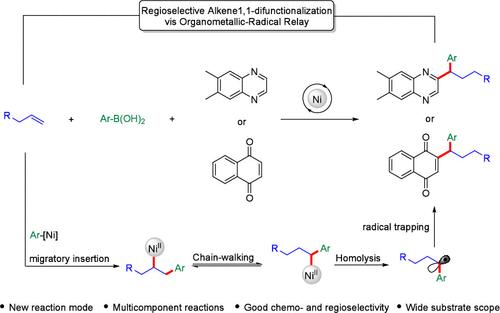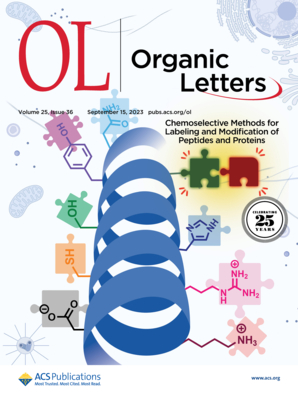镍催化非活化烯烃与喹啉/萘醌和芳基硼酸三组分1,1双官能化的有机金属自由基接力反应
IF 5
1区 化学
Q1 CHEMISTRY, ORGANIC
引用次数: 0
摘要
本研究开发了一种镍催化的分子间三组分 1,1-二官能化方法,通过有机金属-辐射中继,使未活化的烯烃与喹喔啉/萘醌和芳基硼酸发生二官能化反应。这种高效的方案提供了一种新方法,能以中等至良好的产率获得各种芳基烷烃,且具有广泛的底物范围和出色的官能团耐受性。机理研究深入揭示了化学选择性和区域选择性的机理和来源,并证实了功能化苄基自由基的生成。本文章由计算机程序翻译,如有差异,请以英文原文为准。

Nickel-Catalyzed Three-Component 1,1-Difunctionalization of Unactivated Alkenes with Quinoxaline/Naphthoquinone and Arylboronic Acids via Organometallic-Radical Relay
A nickel-catalyzed intermolecular three-component 1,1-difunctionalization of unactivated alkenes with quinoxaline/naphthoquinone and arylboronic acids via organometallic-radical relay is developed. This efficient protocol provides a new method to access a variety of arylalkanes in moderate to good yields with a broad substrate scope and excellent functional group tolerance. The mechanistic studies provide insights into the mechanism and origin of chemo- and regioselectivity as well as confirm the generation of functionalized benzylic radicals.
求助全文
通过发布文献求助,成功后即可免费获取论文全文。
去求助
来源期刊

Organic Letters
化学-有机化学
CiteScore
9.30
自引率
11.50%
发文量
1607
审稿时长
1.5 months
期刊介绍:
Organic Letters invites original reports of fundamental research in all branches of the theory and practice of organic, physical organic, organometallic,medicinal, and bioorganic chemistry. Organic Letters provides rapid disclosure of the key elements of significant studies that are of interest to a large portion of the organic community. In selecting manuscripts for publication, the Editors place emphasis on the originality, quality and wide interest of the work. Authors should provide enough background information to place the new disclosure in context and to justify the rapid publication format. Back-to-back Letters will be considered. Full details should be reserved for an Article, which should appear in due course.
 求助内容:
求助内容: 应助结果提醒方式:
应助结果提醒方式:


